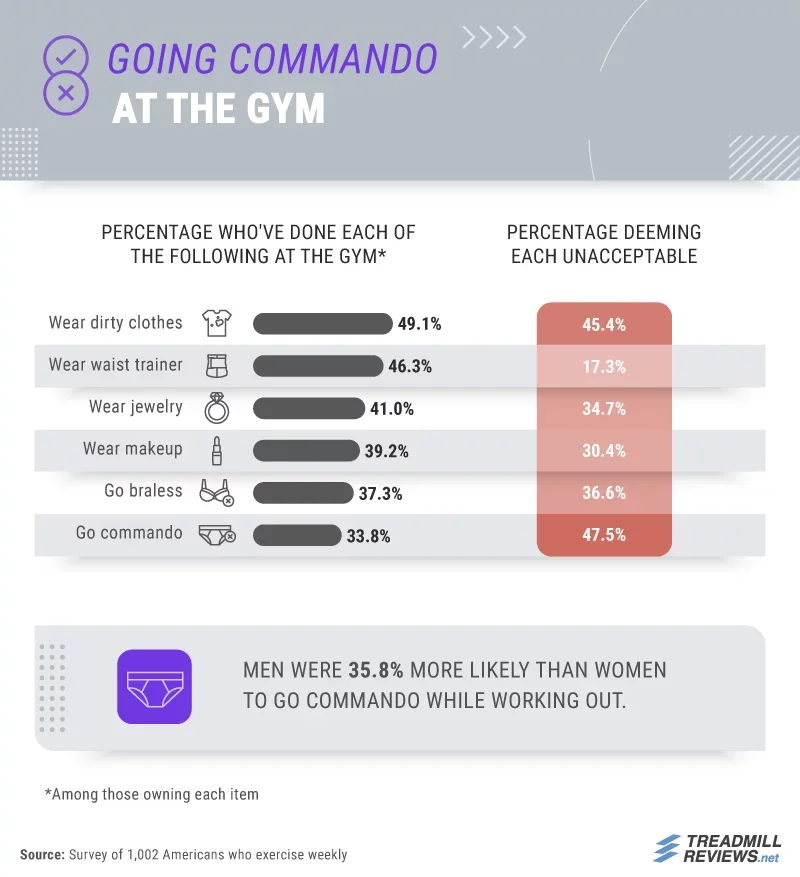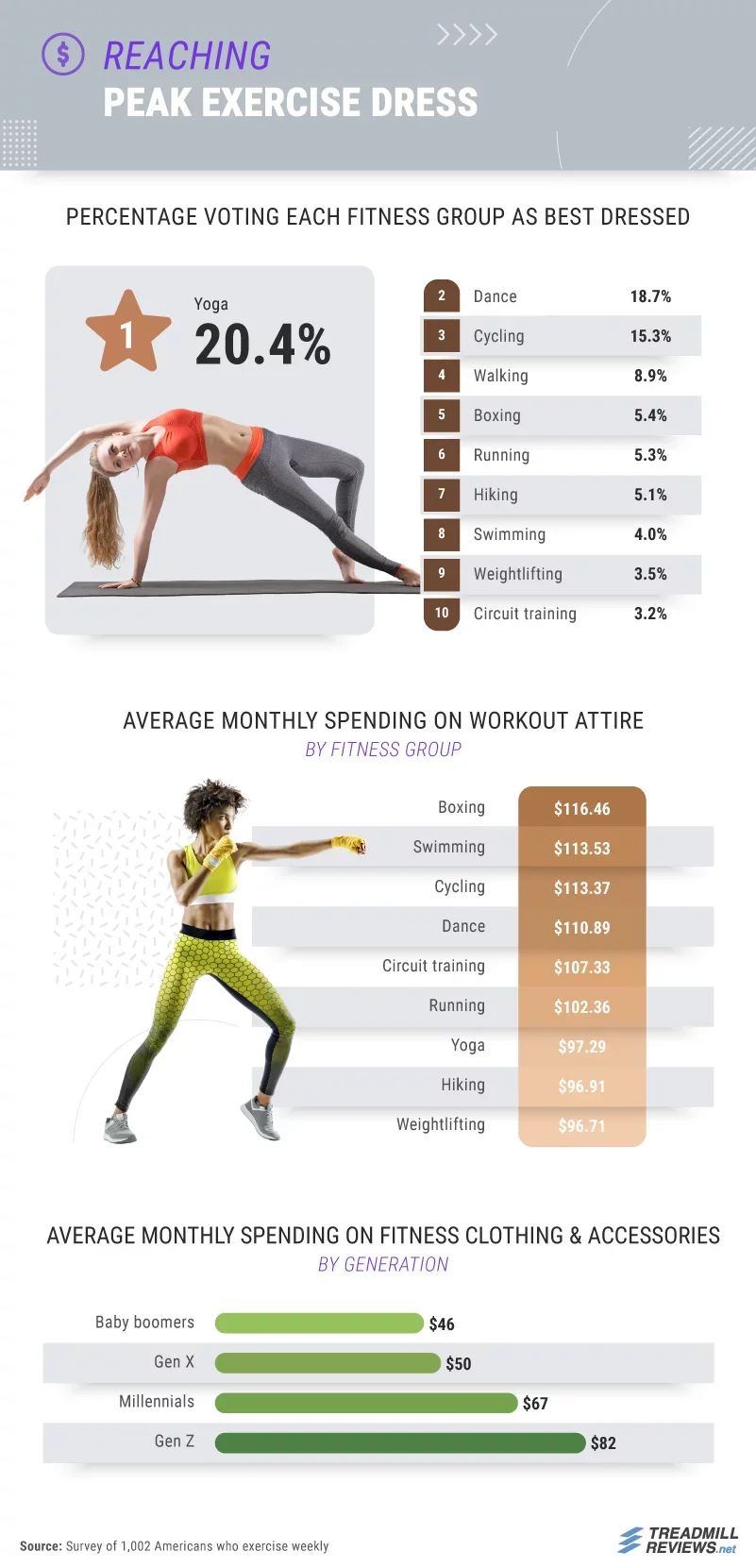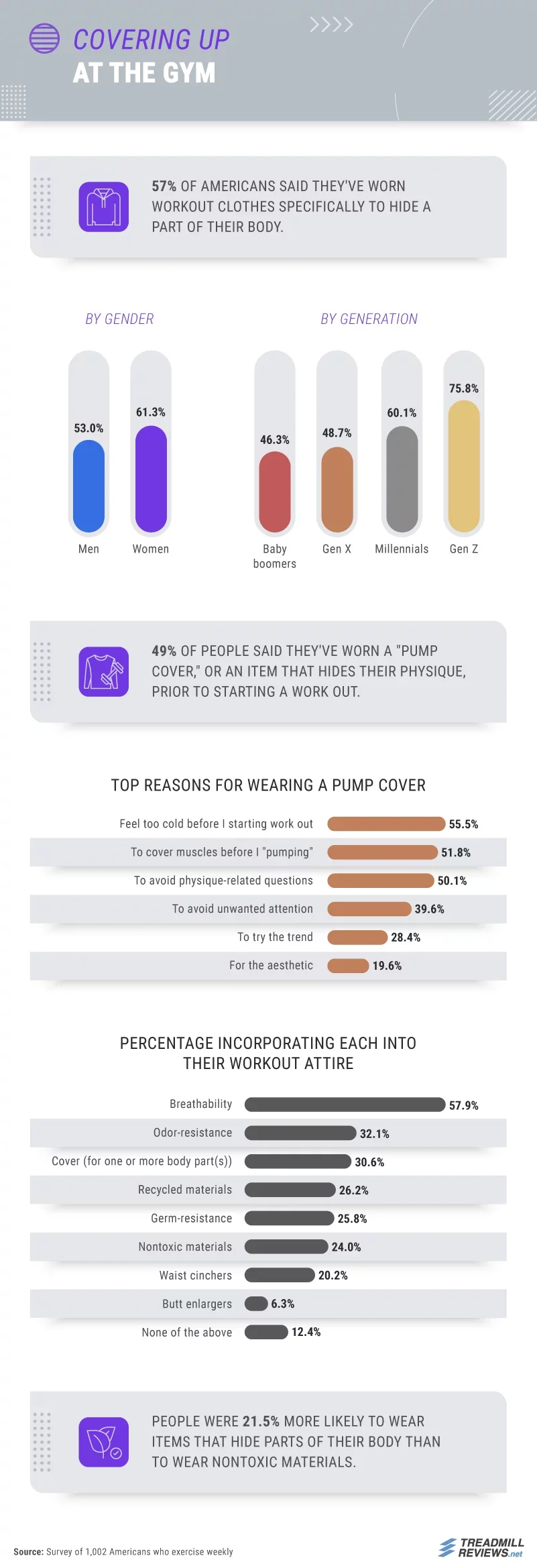More Than a Third of Gym Goers Work Out Without Underwear, Even Though 48% of Their Peers Find This Unacceptable
Highlights
- People who do yoga for exercise were voted the best dressed of all workout groups.
- More than a third of people admitted to working out commando, and men were even more likely than women to do this.
- Nearly half of people said they go to the gym in dirty workout clothes.
- 57% of people bought workout clothing specifically to hide a part of their body.
- Gen Z spent more than any other generation on workout clothes.
Choosing and wearing appropriate workout clothes should be simple, but it appears there will always be some people who complicate things. After talking to more than 1,000 Americans who exercise weekly, it seems people are doing some fairly “unacceptable” things when it comes to their workout attire. From wearing dirty clothes to wearing waist trainers and makeup, we uncovered people’s worst gym habits.
Then there’s an even darker side to the story, where people are often purchasing workout clothes to hide or change the shape of themselves. To see what it’s really like to get dressed and ready for the gym in America today, keep reading.
The Most Offensive Exercise Behavior
First we wanted to know what bothered people the most at the gym, so we asked about the most common behaviors gym goers actually reported doing themselves and gauged people’s limits for the various offenses.
People were most bothered by gym members who either wore dirty clothes or went completely commando. Perhaps both can give off unpleasant odors, ruining the experience for everyone else. Even with this public disapproval, nearly half of all respondents—exactly 49.1%—said they’ve donned dirty clothes to work out. As far as going commando was concerned, men were actually the most likely ones to do this, with more than a third admitting to regularly doing so.
Wearing jewelry and makeup to the gym were other common behaviors that bothered roughly a third of people. Dermatologists advise against wearing makeup to the gym, explaining its potential to congest pores. Jewelry could also be considered as somewhat of a hazard at the gym, but perhaps there’s more to be said for looking exactly how you want while you work out.
The True Cost of a Good Workout Outfit
So what did people approve of, or even adore, for workout clothing? This piece of research asks respondents to vote for their favorite workout-wear style. Then we asked people who did those workouts how much they spent on their gear, which we also compared by generation.
Yoga clothing was a crowd favorite. Over 20% of respondents chose this group as “best dressed”—more than any other type of workout. Dancers came in a close second. While not as many people were a fan of boxers’ clothing, this group was ultimately spending the most to look the way they do.
Gen Z was the biggest spender on workout attire of all the age groups. Every month, this group spends $82 on workout clothing which reflects the propensity of younger generations to spend vastly more than any other on social media-related purchases.
Not All Workout Brands Are Created Equal
Respondents were next given a chance to share not only their personal favorite brands but the ones they felt did the most (and the least) to help general body positivity. Especially during a time when body insecurity and plastic surgeries are at an all-time high, this type of information becomes especially important while shopping.
Everybody’s most favorite brands—Adidas and Nike—were also the ones people felt were doing the most to encourage and promote a healthy body image. They also agreed that a solid black color, which both brands have right in their logos, were the most motivating for their workouts.
As much as people loved the way yoga clothing looked, most of the yoga brands were considered the least body-positive. Athleta, Sweaty Betty, and Lululemon were the top three most often voted for promoting an unhealthy body image. Lululemon has been chided for its lack of inclusive sizing in the past, although it has recently made moves to begin offering larger sizes.
Using Clothing To Hide and Reshape
Moving further into workout clothing’s relation to the body, we wanted to give respondents a chance to share some of their insecurities and how they relied on different pieces of clothing to change—or hide—a part of their look.
More than half of respondents shared that they had chosen and worked out in clothes specifically with the intention of hiding a part of their body. Women and or Gen Zers were especially likely to do so.
But there were other, less shame-oriented, reasons for covering up at some point in a workout. For instance, 49% of people wore what are known as “pump covers” to work out, or something that hides their physique. More than half reported using these simply because they were too cold before starting to move. Fifty percent also said they wanted to avoid unwanted questions about their physique. Nearly 20% simply liked the way a pump cover looks.
Hiding parts of the body was even more important to people than choosing nontoxic materials. In fact, people were 21.5% more likely to choose the former than avoid materials that are reportedly toxic to the human body. Breathability was the single-most important factor, however, for choosing workout clothing overall.
Getting Dressed for Your Workout
Respondents definitely had some opinions about what people should and should not wear to work out. But, mostly, they were just bothered by people who didn’t care to put on clean clothes (or even any underwear).
So long as you’re dressed in something that makes you feel good and enables you to move your body, it should be appropriate for working out. The same goes for choosing the right workout equipment once you’ve finished getting dressed. TreadmillReviews.net helps you find the right treadmill for your specific budget, aesthetic, size, and other preferences. To get help from the experts and the public at large on finding your perfect treadmill, head to our homepage.
Methodology and Limitations
For this study, we surveyed 1,002 Americans who exercised weekly. Of these respondents, 218 were baby boomers, 269 were from Generation X, 321 were millennials, 190 were from Generation Z, and four were from other generations. 517 respondents identified as men, 475 identified as women, and 10 identified as nonbinary. The data we are presenting relies on self-report.
Fair Use Statement
What’s your opinion on what’s best to wear to the gym? If you think this research is helpful for your audience, you may share it with them. Just be sure your purposes are noncommercial and that you link back to this page.





